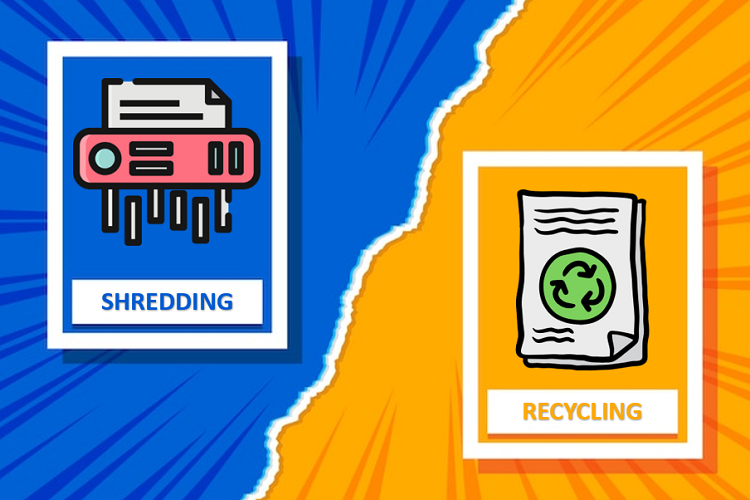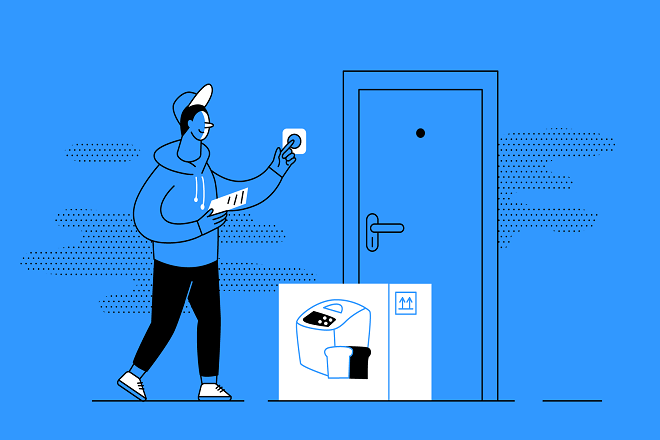Shredding and recycling are two notable approaches to disposing of paper and reports in an innocuous to the biological system way. Notwithstanding, many individuals mistake destroying for reusing or keep thinking about whether a destroyed paper can be reused.
Understanding the vital differences between paper shredding and recycling is significant for legitimate archive removal. Destroying and Reusing alludes to disposing of paper materials, reports, hard drives or other secret data by cutting, crushing, breaking down or in any case making the information unintelligible.
Destroying renders the data lost for security purposes. Reusing gathers disposed of paper, cardboard, jugs and jars to be remanufactured into new materials as opposed to sending them to the landfill. While the two terms manage dealing with squandered paper, shredding and recycling have unmistakable purposes. Peruse on to comprehend when to shred or reuse paper alongside tips for eco-accommodating record annihilation.
Should You Shred or Recycle Sensitive Paper Documents?
With regards to discarding delicate, classified or individual records, destroying is suggested over reusing. Here’s why shredding and recycling are essential for private papers:
- Shredding destroys private data, preventing identity theft if documents are improperly accessed. Recycling does not destroy data.
- Shredding renders documents unreadable. Once destroyed, papers can’t be reproduced.
- Shredding provides peace of mind knowing your sensitive information is secure.
- Most document shredding services provide a certificate of destruction for liability purposes.
- Businesses and organizations often have mandated data security policies requiring shredding.
For non-private archives like garbage mail, papers or regular scratch paper, reusing seems OK. Yet, when security and protection are a worry, legitimate paper destruction is the most effective way to keep private data from getting into some unacceptable hands.
Is It Possible To Recycle Shredded Paper?
Generally speaking, destroyed paper can’t be reused. At the point when the paper is destroyed into slim strips or little pieces, the fibre length turns out to be excessively short for reusing handling. Here are a few key reasons destroyed paper is unacceptable for reusing:
- The mixed paper shreds are too small to extract the fibres needed to make new recycled paper. Shredded strips from documents may be mixed with other materials like paper clips, fasteners or adhesives making them unsuitable for repulping.
- Shredded paper is difficult to sort at recycling facilities. The mixed shred sizes and shapes cannot be easily identified or separated.
- Shredded strips can clog up processing equipment at recycling plants causing operational issues.
While destroying is perfect for security, it makes paper non-recyclable. In any case, there are eco-accommodating ways of disposing of destroyed archives if reusing isn’t a choice:
- Compost shredded paper along with food scraps or yard waste.
- Explore specialized shredding and recycling services in your area that may handle shredded paper separately.
- Save shredded paper for animal bedding or packaging material when mailing packages.
- When shredding sensitive materials is a must, find alternate “greener” solutions for the shredded remnants rather than sending them to a landfill.
Where Can I Shred Papers in My Community?
Paper shredding often take place in the parking lots of schools, churches, libraries, banks or community centres. Residents can bring confidential personal and financial documents for professional on-site shredding.
Check online local area occasion schedules or search for occasion flyers in and out of town. Destroying occasions give agreeable, helpful record obliteration so inhabitants can keep away from the development of delicate materials at home requiring removal.
Why is Upcycling Better Than Recycling?
Upcycling is a more maintainable choice contrasted with reusing in a few key ways:
- Requires less energy, processing and resources compared to mechanically breaking down and reforming materials in recycling.
- Diverts waste from landfills by finding creative reuse for discarded items. Recycling also reduces landfill waste but requires more transportation and processing.
- Transforms waste into something unique and usable again, giving new life to otherwise discarded materials.
- It can handle small volumes more easily. Some creative upcycling takes materials that may not be economically recycled on a large scale.
- Generates less waste in the reuse process. Recycling always creates some unusable waste in the breakdown process.
- It is accessible to individuals. Creative upcycling can be done on a small scale while recycling requires larger industrial processes.
The main advantages of upcycling are requiring fewer resources, repurposing waste in creative ways and minimizing additional waste. However, recycling is still essential for some waste streams that cannot be upcycled. So it’s often best to try to upcycle materials when viable, but utilize recycling processes when needed.
What is an Example of Recycling and Upcycling?
Reusing and upcycling are two harmless to ecosystem ways of reusing materials as opposed to discarding them. Here are some examples:
Example of Recycling:
- Taking old glass bottles, breaking them down, melting them and reforming new glass products.
- Processing used paper and making it into recycled paper towels or toilet paper.
- Collecting aluminium cans, and scrap metal and reforming them into new cans or automobile parts.
- Grinding up old asphalt and concrete to use as the aggregate in new pavement mixtures.
Example of Upcycling:
Making coasters, placemats or wall art from old vinyl records.
Transforming used pallets into new furniture like chairs, shelves or tables.
Turning old license plates into decorative wall hangings or memo boards.
Creating purses, bags or organizers out of retired sail cloth, military uniforms or tweed jackets.
Making earrings, pendants and beads from recycled magazines, maps or scrap metals.
So in summary, recycling breaks down used materials making the same or similar products, while upcycling reuses discarded items to make something of higher value or quality.
Proper Disposal: Shredding vs. Recycling
Settling on shredding and recycling relies upon the responsiveness of your reports. Use these tips for easy disposal:
Shred:
- Financial statements with account numbers
- Medical records with personal information
- Old tax documents
- Pay stubs or other payroll docs
- Legal contracts or documents
- Anything with account logins, passwords or PINs
- Hard drives and thumb drives
Recycle:
- Junk mail and advertisements
- Newspapers and magazines
- Scratch paper for notes
- Printouts and everyday documents
- Non-confidential office paper waste
- Cardboard, paperboard and packaging
- Paper cups, containers and wrapping paper
When in doubt, shred. Destroying desk work could make a couple of additional strides than throwing it in the reusing receptacle, however, it’s worth the effort to safeguard your protection and individual information.
What Are The 2 Types Of Recycling?
In this paragraph, we will explore two types of recycling:
Mechanical Recycling
This involves collecting recyclable materials, sorting them by type, processing and then mechanically reforming them into new products. It relies on industrial processes. Examples include creating recycled paper from used paper or forming new aluminium cans from scrap metals.
Chemical Recycling
Also known as tertiary recycling, breaks down materials into their chemical components. The resulting chemicals or raw materials are then used to make new materials or products. For example, chemically recycling used plastics back into petroleum feedstocks for producing new plastic materials again.
Within these two major recycling categories, there are more specialized recycling processes:
- Primary Recycling – Turning waste materials back into the same kind of product, e.g. recycling paper into paper.
- Secondary Recycling – Transforming waste into other materials of lower quality, e.g. recycling PET bottles into fiberfill for jackets.
- Tertiary Recycling – Degrading waste chemically into its original form to manufacture the same product.
- Quaternary Recycling – Conversion of waste into energy, e.g. incinerating waste to produce heat or electricity.
The two broadest types are mechanical recycling utilizing reuse processes and chemical recycling breaking down materials on a molecular level. Understanding these centre reusing standards and their different applications is critical to more readily squander the executives.
What is the Reason for Paper Shredding and Recycling?
Destroying And Reusing alludes to the obliteration and removal of private papers, hard drives, information tapes or other delicate data. Destroying is done explicitly to deliver archives unintelligible and forestall the remaking of information.
Paper Shredding
Here are some key reasons for shredding paper materials:
- Prevent identity theft – Shredding protects personal information from being stolen and used for fraud. Recycling does not destroy data.
- Destroy confidential business records – Companies shred to avoid data breaches which can lead to legal ramifications and loss of consumer trust.
- Uphold security compliance – Government agencies and contractors have mandated shredding to meet data security protocols.
- Provide personal peace of mind – Individuals shred financial, legal and medical records for privacy.
- Render documents irrecoverable – Once shredded, it is nearly impossible to reconstruct paper documents or data devices.
Proper paper shredding is critical whenever the protection of sensitive information is essential. While it creates waste, shredding eliminates the risk of personal, financial or institutional data falling into the wrong hands.
Paper Recycling
Reusing alludes to gathering and going back over utilized paper, cardboard, holders and different materials. Recycling allows discarded products and packaging to be transformed into new materials and products rather than sending waste to landfills.
The goals of paper recycling include:
- Reducing landfill waste – Paper makes up over 25% of landfill waste. Recycling diverts paper from landfills.
- Creating new recycled paper – Used paper is turned into new recycled paper towels, tissues, notebooks and more.
- Saving trees and resources – Making recycled paper reduces the need for virgin tree pulp and extensive water and energy resources.
- Building a circular economy – Old paper materials become feedstock for manufacturing new paper products in a closed-loop system.
- Supporting maintainability – Reusing is a vital part of earth-dependent waste administration.
Dissimilar to paper destruction which disposes of reports, reusing expects to recuperate squander paper strands and keep them available for use. For non-classified records, reusing is the best finish-of-life arrangement.
Is It Better to Shred or Recycle Sensitive Documents?
Shredding is highly recommended for confidential papers to prevent identity theft and destroy personal data.
Can I Include Shredded Paper with My Regular Recycling Pickup?
No, most reusing focuses don’t acknowledge destroyed paper since it can’t be gone back over.
Conclusion
In rundown, destroying and reusing offer harmless to the ecosystem ways of taking care of reports and paper squandering. Destroying obliterates private information however it can’t be reused. Reusing transforms disposed of paper once again into usable fibre yet misses the mark on the security of destroying.
With regular paper squandering, reusing is the better decision to lessen landfill squandering. Upcycling additionally imaginatively reuses squandering in an eco-accommodating way.
Understanding the central distinctions between destroying as opposed to reusing, mechanical versus synthetic reusing processes and upcycling as opposed to reusing permits us to settle on better decisions to deal with materials in the absolute most maintainable manner.
As customers and organizations search for green arrangements, these waste administration rehearses are critical to diminishing natural effects.







![10 Best Sites Like FMovies – Free Alternatives [2025]](https://www.uplarn.com/wp-content/uploads/2022/01/fmovies.png)




